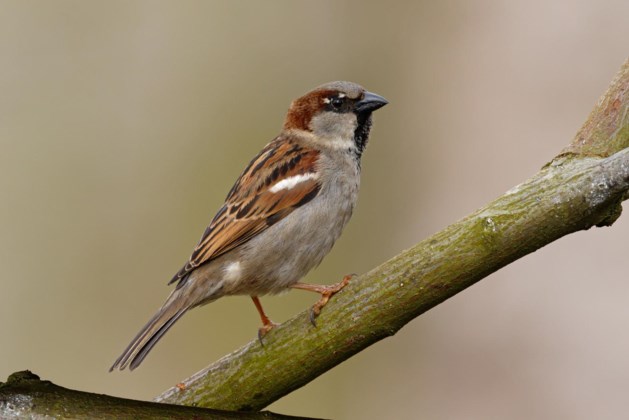More than 46,000 bird lovers took their abacus to hand last weekend for the 21st Great Bird Counting Weekend, an initiative of Natuurpunt. On average they saw 22 birds of seven different species in their garden. Good for a total of 724,776 birds. The most common was again the house sparrow, which was spotted in about half of the gardens. A result that, according to Gerald Driessens, bird expert at Natuurpunt, must be put into perspective a bit.
Although their breeding ground is threatened, the house sparrow remains the most common bird in our Flemish gardens. — © rr
“It’s double. The house sparrow always does well, because it is a resident bird that stays close to its breeding ground and is therefore often found in gardens. But the fact that we are all trying to build more energy-efficiently means that they are also threatened. They need all those cracks and holes that we are now closing en masse to breed. We would therefore like to call on people to definitely install nest boxes.”
The top three is further completed by the great tit and the jackdaw. For the latter, it has been since 2020 that she has been this high. “The jackdaw is doing very well,” confirms Driessens. “They benefit from the fact that they travel in groups. They can communicate non-verbally very quickly, both to warn of enemies and to indicate food.”
(Read more below the photo)
The great tit. — © fvv
A species that is also doing remarkably well is the great spotted woodpecker. The top 10 is still a bit too ambitious, but compared to five years ago, the great spotted woodpecker is now sighted twice as often. Last weekend she was spotted in 15 percent of the gardens. A nice observation, says Driessens.
“People like to see the great spotted woodpecker because it is such a colorful appearance. The fact that it is on the rise is probably due to the aging of our trees. After the war, many trees were planted in Flanders. Now they have matured enough to have many dead branches. The woodpecker is therefore increasingly finding its place in our gardens.”
Merel wins, finch loses
Driessens also points out the surprising result of the blackbird. The Usutu virus caused mass mortality among that species for years, but now the blackbird has risen one spot again, from eight to seven. “However, it is difficult to draw many conclusions from this. We do not know whether it concerns an increase in northern blackbirds, a species that simply comes to spend the winter here, or whether it concerns blackbirds that actually breed here. We hope for the latter, because that could be a sign that the species is starting to recover again.”
Where there are winners, there are also losers. The finch, for example. It was in third place last year, but has now fallen to sixth place. “How does that happen? Because the finch is a fairly unpredictable species,” Driessens explains. “They move very easily depending on where there is a lot of food supply. For example, if you have a long, severe winter, where their winter supplies are frozen or snowed under, they will come looking in our gardens. But if they find enough food in nature, as is probably the case now, then they should not take the risk of coming close to humans. The fact that she is now seen less often does not necessarily say anything about the coming years.”
Top 10 in Flanders
House Sparrow Great Tit Jackdaw Wood Pigeon Blue Tit Finch Blackbird Magpie Collared Dove Starling
